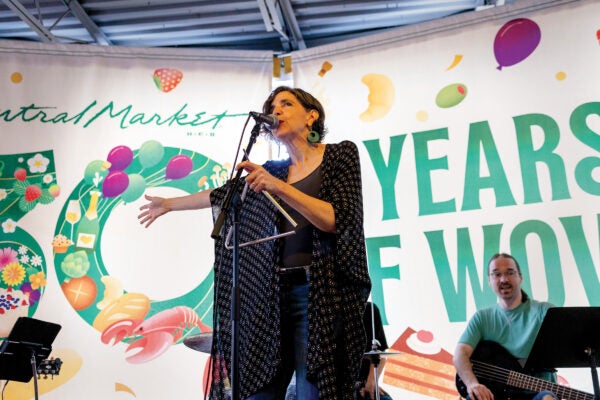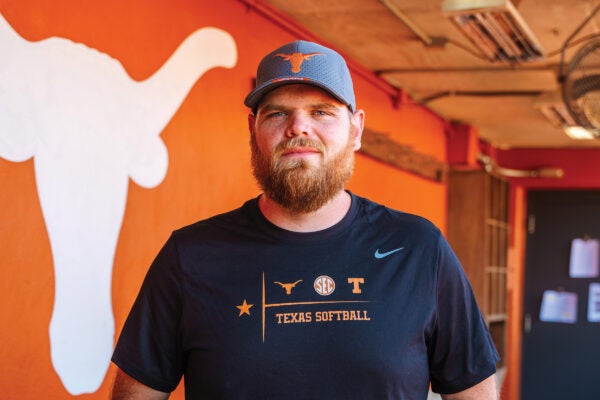A mother took her 8-year-old for a dental checkup. The dentist began normal procedures and asked the girl her name. She stuttered her answer.
“Are you nervous?” the dentist asked jokingly.
With full confidence, the girl replied: “Oh! I’ve heard of people like you. You don’t know about stuttering. Stuttering is a neurophysiological disorder. It’s a genetic thing because my uncle actually stutters too. If you have any questions about it, I’m happy to answer them.”
Children and parents in previous generations misunderstood stuttering. They were taught to hide the condition and play it off as something else, says Geoffrey Coalson, a stuttering specialist at the Arthur M. Blank Center for Stuttering Education and Research. This girl, however, showed her confidence and was an advocate for herself. She acquired these tools for empowerment at the Blank Center’s summer camp, Dream. Speak. Live.
Arthur M. Blank partnered with the Moody College of Communication in 2020, awarding them a $20 million legacy grant to establish the Blank Center. The facility is an overarching center built to expand the vision and work of Courtney Byrd, who founded and directed the Michael and Tami Lang Stuttering Institute, the Dr. Jennifer and Emanuel Bodner Developmental Stuttering Laboratory and the Dealey Family Foundation Stuttering Clinic on campus.
The mission of the Blank Center is to implement groundbreaking research in stuttering treatment methods for children, teenagers and adults worldwide.
Arthur M. Blank, co-founder of The Home Depot, is a person who stutters and sees a need to bolster treatment options. He said the partnership allows for a plan to establish satellite centers across the U.S and provide communities outside Austin access to the camps, which are weeklong programs to help improve the quality of life of people who stutter.
One in every 100 people worldwide stutter, according to The Stuttering Foundation.
Stuttering is a biological and neurological disorder defined by an atypical disruption in the flow of speech. Without treatment or understanding of the complex nature of the pathology, one’s academic, emotional or social life can be affected.
According to Byrd, traditional therapy focuses on fluency, which is unrealistic because one’s stutter will never disappear. The Blank Center instead focuses on empowering individuals of all ages to communicate effectively and confidently through a whole-person therapeutic approach.
In the accounts below, three staff members highlight the Blank Center’s work and influence.
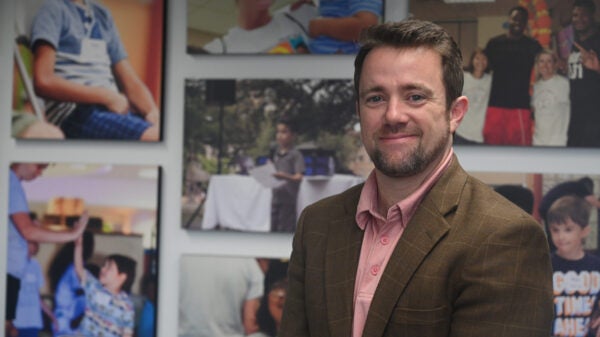
GEOFFREY COALSON
During a speech therapy session as an undergraduate at The University of Texas, Coalson started to push through a moment of stuttering. Instead of trying to change his speech, clinical supervisor Byrd told him to stop and reflect on how he thought and felt at that moment.
Throughout his years of speech therapy, Coalson had fought his stuttering and had never felt encouraged to embrace it.
Ten years later, he returned to the Blank Center not as a client, but as the director of research and grant development.
The penalty for stuttering is far too high. By asking children who stutter to hide their stuttering, no matter how well intended, it penalizes that child.
Coalson says that speech-language pathology is an evidence-based field and that although stuttering is one of the oldest diagnoses, it is the least popularly treated disorder. His research examines the effectiveness of new treatment options that pivot away from fluency to ensure the right outcomes for those who stutter.
“We don’t try to suppress or eliminate stuttering,” he says. “We test communication competence as viewed by the person who’s speaking to see if it’s making a difference on their overall quality of life. That’s where the research is lacking.”
The Blank Center was active for seven years under various names. Coalson says that researchers possess a wealth of clinical data and that he hopes the findings will show the short- and long-term effects of treatment.
The goal is to publish the data and invite outside engagement beyond investment. For example, to propel the program forward, benefactors could facilitate progress for policies at the education and insurance levels in the U.S.
Coalson says one downside to the research is that it’s very homogenous and Western-centric. New research at the center focuses on how stuttering operates in a bilingual and multilingual environment to examine the effect on cognitive abilities, quality of life and how those may differ across languages and cultures.
All research is collected from the participants, Coalson says. Both children and adults are seen and undergo diagnostic testing at the beginning and end of their 12-week treatment. Throughout therapy, participants learn strategies to advocate effectively, make friends and speak confidently. The testing then focuses on how well one communicates rather than the nature of fluency.
In the summer, Coalson is a leader at the Blank Center’s Dream. Speak. Live. camp. The sessions, which are offered worldwide, offer children who stutter the opportunity to explore their individual authenticity, which gets lost when pursuing fluency.
“A lot of emotional and cognitive aspects get overlooked; so we want kids to know how to disclose that they stutter and not apologize for it and advocate for themselves,” Coalson says. “It’s really heartwarming to see kids not trying to hide a part of who they are.”
Coalson’s two daughters participated in the Austin camp session this July. The camp allows like-minded individuals to develop good communication techniques alongside each other. “It’s a wonderful culture to share with my kids for sure,” Coalson says.
He says he feels that it is empowering to see people who stutter in influential, successful positions, such as Arthur M. Blank, actor James Earl Jones and President Joe Biden.
Coalson hopes researching more effective treatment options will alleviate pressure to speak fluently.
“This is overdue,” Coalson says. “The penalty for stuttering is far too high. By asking children who stutter to hide their stuttering, no matter how well intended, it penalizes that child. Fluency, at its core, is an apology. … It took a whole generation of those who grew up stuttering, who are now successful, to put back into the system and guide it in the right direction to help future (generations).”
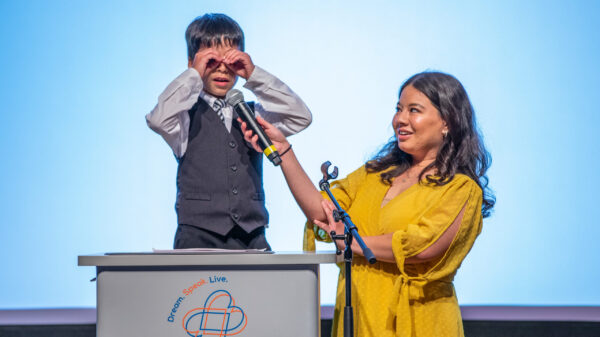
ANDREA CHEE
As an undergraduate at the University of Texas, Chee worked the front desk at the Blank Center, then known as the Stuttering Institute. She felt like a sponge soaking up participants’ journeys, colleagues’ guidance and groundbreaking research.
She attended graduate school, received her license to practice speech-language pathology from Texas Christian University and joined the Blank Center team as a speech therapist in 2021.
Chee says she is eternally grateful for her undergraduate experience because her graduate program only offered two sessions with people who stutter. The time she spent at the Blank Center led her to her passion.
Chee is trained to work with bilingual and multilingual individuals to see how stuttering manifests itself in both languages. She applies cutting-edge research by staffers such as Coalson to her therapy method.
Sometimes bilingual populations are overdiagnosed for stuttering because if they’re learning one language at home and English at school, they tend to have disfluencies, such as repeating sounds or words, Chee says. These tendencies can be misdiagnosed for other speech impairments, and therapy can be implemented for no reason.
Chee says bilingual individuals who stutter also may be less likely to speak their second language due to limited vocabulary and the inability to switch between words.
“If you speak three languages fluently, you will stutter in all of them,” Chee says. “So it’s really important to get people the right resources and point them in the right direction.”
To fully dedicate time to bilingual speakers, Chee created a summer program for participants who stutter in both Spanish and English. The attendees shared their experiences growing up in a bilingual household while stuttering and received advice on how to communicate with confidence.
“One participant talked about growing up in a Mexican household where you’re teased for everything and (they were) teased for stuttering, but (teasing is) a form of endearment. So you’re mad but also feel loved,” Chee says. “It’s very interesting and bilingual-specific.”
During the semester, Chee also runs individual and group therapy sessions for children and adults who are both monolingual and bilingual.
Current policies in place for those who stutter aren’t as effective as they could be, Chee says. For example, therapy and evaluations are unaffordable when they cost from $100 to $250 a session, and when the sessions are free, like in a school setting, those who stutter are grouped with students with other speech impairments, such as the inability to make the “r” sound.
“When working with a child who stutters, you’re telling them to accept it because there’s no cure, but with other speech impairments, you’re like drill, drill, drill to practice making the sound,” Chee says. “It’s counterintuitive to group very different speech impairments into one treatment session.”
Chee is excited to see the bilingual program grow, especially as camp sessions for Dream. Speak. Live. spread to the international community. Chee says that although multilingualism and stuttering are new research sectors, the discoveries will benefit from a wide range of people previously overlooked.
“I’m a speech therapist, and I’m there to help them, but I truly feel like they helped me more,” Chee says. “It’s so meaningful that people allow me to come into their lives and do what I do.”
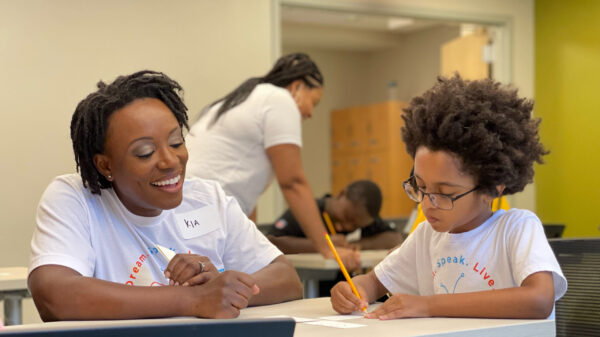
KIA JOHNSON
Initially a pre-med student, Johnson entered the world of speech-language pathology because of her love of communicating with others. Not everyone has the same access to communication resources, so Johnson and the Blank Center sought to eliminate that barrier.
Johnson says she is passionate about diversity, equity and inclusion. She wanted to bring a resource for speech therapy to Atlanta — a city with a vastly underrepresented racial and minority population in need of affordable treatment options.
“Seeing the smile on parents’ faces when their speech-language pathologist looks like them is important,” Johnson says. “The children and parents are able to see an example of what anyone’s future could be like.”
Johnson says the Blank Center is passionate about cultural diversity. Part of the motivation to put a satellite in Atlanta was to diversify the demographic the center is aiding.
“Austin’s center is based out of UT, so it is university-based,” Johnson says. “In Atlanta, we’re not connected with a university which creates a variety of diversity in age of participants and economic status. It’s important to have representation for the communities we’re serving.”
As associate director of the Blank Center Atlanta satellite, Johnson says her role is to replicate and enforce the mission and vision of the Austin base. She also serves on the board of directors of the American Speech-Language-Hearing Association and is the president of the National Black Association for Speech-Language and Hearing.
Holding a sizable role in leadership within the speech-language pathology community, Johnson says goals and opportunities often overlap. At association meetings, she can insert her knowledge and expertise in stuttering. With students at the Blank Center, she advises them on certification work or doctoral programs to kick-start their careers.
Johnson decided to focus on stuttering because although the diagnosis is the same for each person, the journey of the individual who stutters is different. “Their outlook, their journey, their presentation of stuttering, their feelings and attitudes about stuttering will differ,” she says. “And if you’re able to change the attitude or how they view themselves, you can have a significant impact on their future or outlook on life.”
Johnson says there is a greater emotional charge with stuttering whether positive or negative. In traditional therapy, people who stutter may feel like they’re not working hard enough or understanding therapy sessions because they’re not achieving fluency. Transitioning the message from “fluency is good, stuttering is bad” to “let’s work on being a great communicator” can change the perception of stuttering.
Her favorite part of her job is talking to the parents about their child’s progress and seeing their child gain confidence and communication skills at no cost. Johnson says eliminating that access barrier to communities is important, especially in a city such as Atlanta with a diverse range of socioeconomic backgrounds.
Atlanta is the first satellite facility of many planned to crop up across the U.S. The goal is to build enough locations so members of various communities can connect with speech-language pathologists.
“Everything we’re doing, we’re doing to support the stuttering community, which is an all-encompassing thing,” Johnson says. “The opportunities, the networks, the life experiences are all to help impact those who stutter in the future.”


